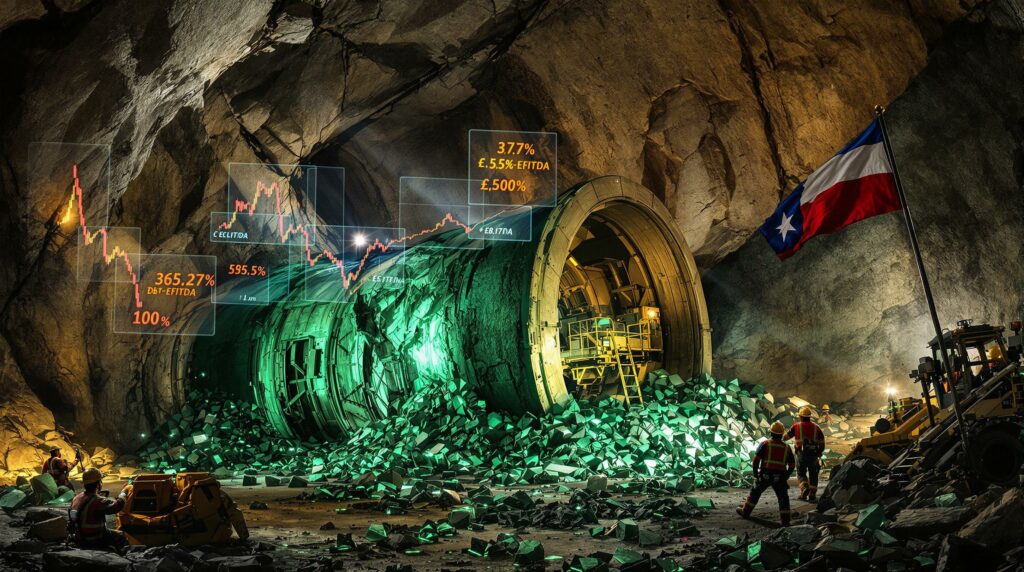Understanding the El Teniente Mine Disaster
The July 31, 2025 tunnel collapse at Codelco's El Teniente copper mine sent shockwaves through Chile's mining industry and global copper markets. This catastrophic event claimed the lives of six workers and caused extensive damage to critical mine infrastructure, raising serious questions about the company's operational practices and financial stability.
What Happened at El Teniente?
Initial damage assessments following the collapse estimated approximately 700 meters of affected tunnel. However, subsequent investigations by the Public Prosecutor's Office revealed a far more extensive impact, with approximately 3.7 kilometers (2.3 miles) of tunnels damaged throughout the underground complex.
The full extent of the damage remains partially unknown, as investigators still need to deploy specialized drones to access the worst-affected areas where human entry remains unsafe. These remote assessments will be crucial for developing a comprehensive recovery plan and understanding the true scale of the disaster.
"The collapse damage is substantially more extensive than initially reported, making this one of the most significant mining disasters in Chile's recent history." — Mining safety expert quoted in Bloomberg News
Areas Impacted by the Collapse
The collapse primarily damaged a newer mining section called Andesita, located approximately 900 meters underground. This section represented a significant portion of El Teniente's future production capacity and had been part of Codelco's modernization efforts.
Contrary to initial company statements, the five-year-old Recursos Norte section also suffered significant damage during the collapse. This additional impact compounds the operational challenges facing the company, as Recursos Norte had been a key production area within the mine complex.
El Teniente is not just any mine in Codelco's portfolio—it accounts for approximately 25% of the company's total copper production and generates a substantial portion of its profits. As a 120-year-old operation, it represents both the historical foundation and a critical component of Codelco's future plans.
Operational Consequences of the Disaster
The operational impact of the El Teniente disaster extends beyond the immediate tragedy, threatening Codelco's production targets and recovery plans during a critical period for the company.
Current Production Status
El Teniente partially resumed operations on August 10, 2025, just over a week after the collapse—a timeline that surprised many industry analysts who had expected a longer initial shutdown. However, this restart only applies to specific areas of the mine complex that were unaffected by the collapse and have been deemed safe for workers to return.
The newer sections of the mine, including the damaged Andesita and Recursos Norte areas, will likely remain non-operational for an extended period. These sections represent significant production capacity that cannot be easily replaced by increasing output from older mine sections.
While the partial restart provided some reassurance to copper markets, it masks the longer-term operational challenges that Codelco now faces with a substantial portion of its flagship mine offline.
Production Implications
The accident disrupts Codelco's ongoing efforts to recover from years of declining output across its mining portfolio. Prior to the collapse, the company had been working toward returning to pre-pandemic production levels of approximately 1.7 million tons annually—a significant increase from current production of around 1.4 million tons.
El Teniente plays a crucial role in these production recovery plans, and the extended shutdown of key sections will likely delay the company's timeline for reaching its targets. This setback comes at a particularly challenging time, as the company faces increasing pressure to improve its financial performance.
"This disruption comes at a time when Codelco was aiming to recover production levels, and some of its targets are likely to be delayed or revised downward. Given ongoing safety concerns, it is unlikely that the mine collapse weighs on Codelco debt even as output resumes to full operations in the near term." — William Snead, BBVA strategist
In a telling sign of the disaster's significance, Codelco delayed reporting its quarterly results and annual production guidance that had been scheduled for August 1, 2025. This postponement suggests the company is still assessing the full impact of the collapse on its financial outlook.
What Caused the Mine Collapse?
Understanding the cause of the El Teniente collapse is crucial not only for preventing future disasters but also for determining the company's liability and recovery timeline.
Initial Findings on Collapse Causes
Early indications from the investigation suggest the seismic event was likely caused by mining activity rather than natural earth tremors. This distinction is critical, as human-induced seismicity often points to potential issues with mining methods, safety protocols, or operational decisions.
Codelco has launched a comprehensive investigation into the collapse, including convening an international panel of mining and safety experts to analyze the causes and recommend preventative measures for the future. This panel will examine geological data, mining practices, and safety protocols in place at the time of the collapse.
Chairman Maximo Pacheco has publicly pledged to take "maximum measures" if company supervisors or executives are found responsible for conditions that led to the disaster. This statement signals the company's recognition of the potential for organizational failures rather than simply natural or unavoidable causes.
Mining Method Concerns
The collapse has raised serious questions about the mining methods used at El Teniente, particularly in the deeper sections where the disaster occurred. As mines extend deeper underground, they face increasing geological pressures and require more sophisticated engineering approaches to maintain stability.
Industry experts, including Juan Ignacio Guzman of GEM mineral consulting, suggest that mining these deeper sections will require a fundamentally new approach. "Mining these deeper sections will require a new approach that will delay plans even further," Guzman noted in an industry briefing.
The block caving method used at El Teniente—which involves undercutting an ore body and allowing it to collapse under its own weight—may need significant modification or replacement with alternative techniques for deeper mining operations. This methodological shift would require substantial additional investment and could further delay production recovery.
Safety concerns make it highly unlikely the mine will return to full operations in the near term, as any resumption plan must prioritize worker safety over production targets. The Chilean government has also signaled increased scrutiny of modern mine planning following the disaster.
Financial Impact on Codelco
The El Teniente disaster couldn't have come at a worse time for Codelco's financial position, adding new pressures to an already strained balance sheet.
Debt Position Before the Collapse
Prior to the collapse, Codelco was already among the world's most indebted major mining companies. The company's debt-to-EBITDA ratio stood at approximately six times earnings—a level that had already raised concerns among credit rating agencies and investors about its financial sustainability.
This high leverage reflects years of declining production, rising costs, and significant capital expenditures on expansion and modernization projects across its mining portfolio. The company faces substantial upcoming debt payments, including approximately $553 million due in 2025 and another $1 billion in 2026.
These debt obligations were already challenging before the El Teniente disaster. Now, with reduced production capacity and additional recovery costs, meeting these financial commitments becomes even more difficult without additional support or restructuring.
How Markets Responded to the Disaster
The initial market reaction to the El Teniente collapse was relatively muted, with investors viewing it primarily as a human tragedy rather than a financial event. However, this perspective began to shift as the full extent of the damage became clear.
In the days following the disaster, the yield spread between Codelco bonds and Chilean sovereign debt widened by approximately 10 basis points. While modest, this widening represented a return to levels seen a month earlier during concerns about potential US tariffs on raw copper imports—suggesting that markets were beginning to price in financial risks associated with the collapse.
Codelco bonds notably performed worse than other major mining peers in the week following the accident, indicating investor concerns specific to the company rather than industry-wide factors. This relative underperformance suggests the market is differentiating Codelco's situation from broader mining sector trends.
"There are many unknowns regarding the extent of the damage and the efforts that it could take not only to alleviate the safety issues, but also to make it fully operational again. Maybe some of them are not being fully priced yet." — William Snead, BBVA strategist
Credit Rating Concerns
S&P Global Ratings issued a warning following the accident, noting that the El Teniente disaster could increase Codelco's already substantial debt burden. The ratings agency specifically highlighted potential limitations on the company's access to new borrowing at a time when it may need additional capital for recovery efforts.
The reputational damage from the accident could have longer-term financial implications beyond the immediate production disruption. Safety incidents of this magnitude often lead to increased regulatory scrutiny, higher insurance premiums, and greater difficulty attracting investment capital—all factors that could further pressure Codelco's financial position.
Market perceptions began shifting more significantly after S&P's warning, with increased pressure on Codelco bonds reflecting growing investor concerns about the company's financial trajectory. This shift suggests that market participants are increasingly factoring the disaster into their risk assessments for the company.
Long-Term Challenges for Codelco
The El Teniente disaster has exposed deeper structural problems within Codelco's operations that extend far beyond the immediate production disruption.
Structural Issues Facing the Company
"The restart of operations at El Teniente doesn't deal with the structural problems exposed by this tragic episode," noted Juan Ignacio Guzman of GEM mineral consulting. This insight captures the fundamental challenge facing Codelco—the disaster is a symptom of underlying issues rather than an isolated incident.
Codelco has been struggling with deteriorating ore quality at its aging mines across Chile. As older sections are depleted, the company must mine deeper and in more challenging geological conditions to maintain production levels. These deeper sections often contain lower-grade ore that is more expensive to extract and process.
All four of Codelco's major expansion projects have exceeded their budgets and fallen behind schedule in recent years. This pattern of cost overruns and delays reflects systematic challenges in project management and realistic planning—issues that will likely complicate the El Teniente recovery efforts as well.
The combination of these factors suggests that production targets are likely to be delayed or revised downward across Codelco's portfolio, not just at El Teniente. The company faces a fundamental need to reassess its operational approach and investment priorities.
Financial Flexibility and State Support
One significant advantage for Codelco in navigating this crisis is that its borrowing is backed by the Chilean state—one of Latin America's least indebted countries with strong sovereign credit ratings. This government backing provides a financial safety net that most private mining companies lack.
According to Josefina Valdivia of Credicorp Capital, the company would likely pay only a moderate premium if it needed to return to debt markets for additional funding. This relatively stable access to capital provides crucial financial flexibility during the recovery period.
However, transparency regarding the accident's impact and recovery plans is critical for maintaining investor confidence. As William Snead of BBVA emphasized, "It is important for management to provide updates, transparency is key." Clear and consistent communication about both challenges and progress will be essential for preserving market access.
The company faces a delicate balancing act between implementing necessary safety improvements and restoring production capacity. Prioritizing safety is non-negotiable after such a disaster, but prolonged production disruptions will further strain the company's financial position. This tension will define Codelco's strategic decisions in the coming months.
What This Means for the Copper Market
The El Teniente disaster has implications that extend beyond Codelco to the broader global copper market, particularly given the metal's critical role in the energy transition.
Supply Chain Implications
El Teniente's partial shutdown has temporarily reduced global copper supply at a time when the market was already facing potential constraints. The mine produces a significant volume of refined copper that feeds into global supply chains for electronics, construction, and increasingly, renewable energy technologies.
The timing of this disruption coincides with increasing copper demand surge driven by the expansion of renewable energy infrastructure and electric vehicle production. Copper's excellent conductivity makes it essential for these growing sectors, creating a long-term demand trajectory that many analysts expect to outpace supply growth.
Production disruptions at major mines like El Teniente can have ripple effects throughout global copper markets, affecting not just immediate supply but also market expectations and investment decisions. Even temporary shutdowns can influence contract negotiations and purchasing strategies for major copper consumers.
Price and Market Response
Copper markets typically react to major supply disruptions, though the full impact depends on the duration of reduced output and broader market conditions. In this case, the partial resumption of operations at El Teniente helped stabilize immediate market concerns about severe supply shortages.
The copper market's response has been somewhat muted compared to historical reactions to major mine disruptions. This moderated response likely reflects both the partial nature of the shutdown and existing inventory levels that can buffer short-term supply fluctuations.
Long-term implications for copper price insights and market dynamics will depend on how quickly Codelco can safely restore full production capacity at El Teniente. If the recovery extends beyond a few months, particularly for the newer high-volume sections, the impact on global copper supply forecast could become more pronounced and lead to greater price volatility.
Recovery Outlook and Next Steps
The path forward for El Teniente and Codelco will require careful planning, substantial investment, and a renewed commitment to safety above production targets.
Remediation Timeline Expectations
Full recovery of the affected sections will likely take significantly longer than the initial restart of unaffected areas. The 3.7 kilometers of damaged tunnels represent complex underground infrastructure that cannot be quickly rebuilt, particularly given the safety concerns that remain active.
Mining deeper sections safely will require revised methodologies and enhanced safety protocols beyond what was previously in place. This methodological shift may necessitate not just repairs but fundamental redesigns of mining approaches in the affected areas.
The international expert panel's findings will influence future mining approaches at El Teniente, potentially leading to more conservative extraction methods that prioritize long-term stability over maximum short-term production. These changes would align with global mining industry trends toward more sustainable and safety-focused operations.
Transparency and Communication Strategy
Analysts emphasize the importance of management providing regular updates about both the investigation findings and recovery progress. This transparency is considered key to maintaining investor confidence during an extended recovery period.
Codelco will need to balance immediate production recovery goals with implementing long-term safety improvements. This balance requires clear communication about priorities and realistic timelines that acknowledge the complexity of the recovery process.
The company's approach to communications during this crisis will likely influence its relationship with investors, regulators, and the Chilean public for years to come. Rebuilding trust after such a disaster requires consistent demonstration of a genuine commitment to preventing future incidents.
Frequently Asked Questions About Codelco's El Teniente Mine Collapse
What is the significance of El Teniente to Codelco's operations?
El Teniente represents approximately 25% of Codelco's total copper production and a significant portion of its profits. The 120-year-old mine is crucial to the company's plans to return to pre-pandemic production levels of 1.7 million tons annually. As one of the world's largest underground copper mines, it also represents an important symbol of Chile's mining heritage and expertise.
How has the collapse affected Codelco's financial position?
The collapse has put additional pressure on Codelco's already substantial debt burden, potentially limiting its access to new borrowing. With a debt-to-EBITDA ratio of approximately six times earnings before the disaster, the company was already highly leveraged compared to industry peers. S&P Global Ratings has warned about possible financial implications, though the company's state backing provides some financial security. Upcoming debt payments of $553 million in 2025 and $1 billion in 2026 create additional financial pressure during the recovery period.
When will El Teniente return to full production?
While parts of El Teniente resumed operations on August 10, 2025, the newer sections damaged in the collapse—including Andesita and Recursos Norte—may remain non-operational for an extended period. Full recovery will likely require revised mining methodologies and enhanced safety protocols, particularly for deeper sections of the mine. The company has not provided specific timeline estimates for complete restoration, suggesting the complexity and uncertainty of the recovery process.
What caused the tunnel collapse at El Teniente?
Early indications suggest the seismic event was likely caused by mining activity rather than natural earth tremors. A comprehensive investigation, including an international panel of experts, is underway to determine the exact causes. The collapse has raised questions about the suitability of current mining methods for deeper sections of the mine, where geological pressures increase substantially. The investigation will examine both technical factors and potential organizational issues that may have contributed to the disaster, with drill results interpretation being a crucial element.
Disclaimer: This article contains forward-looking statements and analysis based on current information. Future outcomes may differ substantially from these projections based on investigation findings, recovery progress, market conditions, and other factors. Financial information should not be considered investment advice. Readers should consult appropriate professionals before making investment decisions.
Ready to Stay Ahead of the Next Major Mining Discovery?
Discover significant mineral finds as they happen with Discovery Alert's proprietary Discovery IQ model, turning complex ASX announcements into actionable investment opportunities. Visit our discoveries page to see how historic mining discoveries have delivered exceptional returns and begin your 30-day free trial today.




